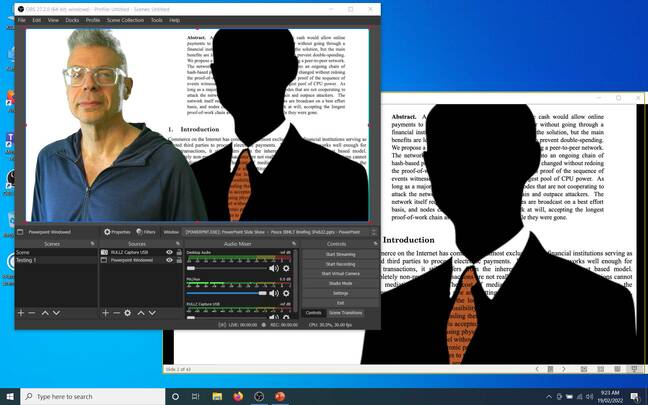This article is more than 1 year old
Apple has missed the video revolution
COVID-19 turned many of us into media producers, but the tools favour Windows
Column The pandemic changed the way I used computers. For most of the 20 years before 2020, I rarely needed or used more than the browser, the mail app, messaging, and a word processor. Other than that I made the occasional foray into image and/or video editing or PDF preparation tools.
Then COVID movement restrictions made it nearly impossible to continue my work as a public speaker. Events disappeared from my calendar as everyone went home – for two years. But it wasn't long before clients came calling again, asking for something that could be delivered remotely.
By this point people had already begun to suffer Zoom fatigue – the result of endless hours squirming beneath the surveillance of a webcam. I reckoned that more of the same would only leave people wanting less of me – a circumstance any public speaker tries to avoid.
Instead I redesigned and rethought how I deliver my talks – making the most of the new normal. With a green screen, a decent camera, lights, and some open-source software, I converted my home office into a television studio. As I learned the tools, my talks became smooth, media-rich livestreams that looked a lot like television – rather than yet another middle-aged dude who hadn't bothered to dress for the occasion speaking monotones into a webcam. Clients loved it, and I found myself with a regular stream of gigs that carried me through the pandemic.
To run my home studio, I'd purchased a beefy but whisper-quiet PC with a powerful graphics card. It all works quite well, and I see no need to change it. But as we negotiate the transition from pandemic to endemic COVID-19, clients ask me to speak in person. I won't need my broadcasting tools for live events, but if I'm on the road for any stretch of time it's probable I'll need to do a broadcast from a hotel room or co-working space or even a friend's home. The PC that drives all of it isn't portable.
I own a MacBook Pro so I put all my software on that. I gave it a try, only to watch the machine struggle and stall under the load. I then gave one of Apple's M1 Pro-powered laptops a whirl: better, but not good enough. Even the fastest Mac won't do the job for me.
My intuition is that this reflects design decisions embedded within differing operating systems. The software I use for compositing and livestreams – OBS – was, before the pandemic, used almost exclusively by gamers. Gaming is PC-centric. The tools gamers use to share their mad skills never get refined on MacOS because there's so little demand. That demand makes all the difference in the world when a new class of applications builds upon those tools.
With the exception of iOS, Apple has always been ambivalent about gaming and 3D. That ambivalence has left its platform behind in this next evolution of personal computing. As a result, after 20 years of almost fanatical devotion to MacOS, I've begun to migrate away from the platform. It stands in the way of my creativity – and my ability to earn a living.
- Microsoft realises constant meetings stress people out, adds Office 365 settings to cut them short or start them late
- Apple arms high-end MacBook Pro notebooks with M1 Pro, M1 Max processors
- The last PC replacement cycle is about to start turning
- Google splurging cash on UK offices to lure staffers back from the kitchen table
In one of my earliest columns, I predicted that we'd never see another upgrade cycle in computing – just the replacement of worn-out machines. The pandemic rescued personal computing from its long, slow decline, because it redefined what we do with these machines. They now enable face-to-face communication – at a distance.
Even as we return to offices, we'll be having more videoconferences more regularly. Personal computers will accommodate this shift into hybrid work by turning into television production studios.
Windows appears well-prepared for this new set of applications, but it looks as though Apple has missed a trick. Its insanely profitable focus on mobile computing means that it may soon find its personal computers relegated to the most boring bits of office work. ®

